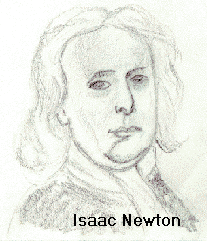Newton's Theories
Cathy D. / Physic#336 / 4 April 1997

For years, Newton and many other scientists, wondered
what kept the moon and planets in orbit. Newton's work in this area, led
not only to an understanding of gravity which is the attraction
of bodies toward the center of the earth, but to theories on how an artificial
satellite might be sent into orbit. The first artificial satellite, Sputnik
1, was finally launched in the year 1957, but only with the use of Newton's
theories.
Newton
Sir Isaac Newton was born on December 25, 1642 in Woolsthorpe, England
in the same year that Galileo died. Newton, an English mathematician and
physicist, was one of the greatest and most influential scientists in history.
His accomplishments in optics, mathematics and physics have laid the foundations
for modern science and revolutionized the entire world.
How Newton's
Theories Came About
Legend has it that Sir Isaac Newton was sitting under an apple tree
when an apple fell and hit him on the head causing him to come up with
the idea of gravity. Actually the apple missed him and made a soft
thud on the ground, but that was enough to attract Newton's attention (Voigt
4). The apple's fall triggered the important realization that a force,
gravity, attracts all bodies in the universe to each other, pulling apples
to the ground and holding the Moon and the planets in their orbits (Voigt
4). In 1729, about two years after his death, a book containing Newton's
theories was published. In it, Newton showed how an artificial satellite
could be launched from the earth. He pictured the earth with a high mountain
and a cannon on top of the mountain firing shots parallel to the ground.
Each time the cannon was fired, more gunpowder was used and the shot went
farther before striking the ground. Because the earth is round, the shots
curved around it. According to Newton's theory, with enough gunpowder,
a shot could eventually go fast enough to circle the earth completely and
come back to the mountain top.
The Soviet
Scientists
The Soviets were responsible for putting Newton's theory into practice.
They did this by using a powerful rocket to raise a satellite high above
the earth and put it in an orbit parallel to the ground at a high speed.
Back then scientists knew very little about the region of outer space.
The orbit of Sputnik 1 helped scientists to learn about the density of
the atmosphere. Although Sputnik 1 only proved Newton's idea, it was responsible
for beginning the space race. Since then many satellites have been launched
and they have increased scientific knowledge and improved communications.
Kinetics
and Force
To understand how satellites are launched, let's take a look at how
force and kinetics work. A force is just a push or a pull,
it can either twist something out of shape such as a spring, or accelerate
(speed up) an object. Kinetics, is the description of motion without
relation to what causes the motion. Velocity is defined as the distance
traveled divided by the time interval.
Newton's Three laws
Newton's first law of motion states that an object remains at rest
unless acted on by an unbalanced force. Therefore without any forces acting
on it a satellite launched into motion would continue to travel at constant
velocity. Newton's second law states that an unbalanced force acting
on an object causes an acceleration, this law is represented by
the equation F = ma. Newton's third law of motion states that an object
experiences a force because it is interacting with some other object.
Conclusion
Because of Newton's theories and the Soviets who applied them artificial
satellites are now in common use. These satellites have vastly increased
our knowledge of the earth, the sun, the planets and the universe.
References Section
Lovell, Sir Bernard. "A History of Space achievements." The
Random House
Encyclopedia.1990.
Naylor, Thomas H. The Cold War Legacy. Massachusetts: Lexington,
1991.
Voigt, Gregory. Space Satellites. New York: New York City, 1987.
"History of Space Exploration." http://nauts. com/histpace/histpace.html.
"Nasa Experimental Communications Satellites," http://sulu.lerc.nasa.gov/dglover/satcom2.html#
Intro.
"Sputnik Satellites and Launch Vehicles." http://nauts.com/histpace/vehiclesNT/
hisputnikNT.ntml.
Unknown,"Satellite, Artificial." Encarta. CD-ROM.
Funks & Wagnalls Corporation,
1993-1995.